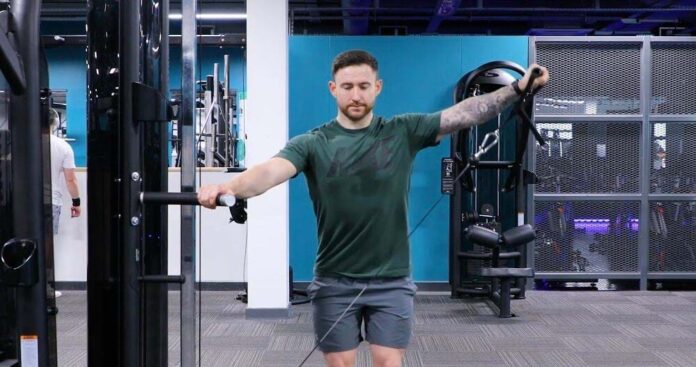Introduction
Lateral raises are one of the most suitable exercises to promote shoulder width, lateral deltoid muscle strength, and definition. Adding them to your workout program will cause you to attain that much-wanted V-tapered physique and increase overall upper body performance. Below is a detailed guide to take you from form to advanced variations so you can maximize gains safely.
Anatomy Awareness: Why Lateral Raises are Necessary
Shoulder joint is the most mobile of the entire body and is stabilized by three humongous deltoid muscle heads:
- Anterior deltoid (anterior)
- Lateral deltoid (medial)
- Posterior deltoid (posterior)
Lateral deltoids isolate the lateral deltoid, the arm-abduction muscle—bringing arm from body midline. Strengthening the muscle not only contributes to appearance but functional strength for execution of ADLs and sports performance improvement.
Performing proper form on lateral raises allows for optimal recruitment of the muscles and reduces the risk of injury. Practice the following step-by-step below:
- Starting Position
- Stand with feet shoulder-width apart and feet wide.
- Stand in a dumbbell position in sides with neutral grip (palms facing inward).
- Have your knees lightly bent and engage your core.
- Execution
Keeping your elbows slightly bent, lift your arms out to the sides slowly until they are parallel to the floor.
Maintain your wrist in a neutral position and do not twist your wrist upward.
- Hold at the top for maximum contraction for one second.
- Lowering Phase
- Slowly lower the dumbbells to the starting position with control.
- Do not use swinging or momentum.
Tip: Slightly lean your shoulders forward, not sideways, to minimize joint stress and contract the deltoid more effectively.
Mistakes to Avoid
Even experienced lifters make mistakes and negate the effectiveness of the lateral raises. Avoid the following mistakes:
Lifting too heavily – Is creating momentum lifts instead of muscle recruitments.
Shrugging the shoulder – Engages the traps rather than the lateral delts.
Locking the elbow – Locks the joints more rather than the muscle.
Lifting too high – Lifting above shoulder height will generally create impingement issues.
Best Variations of Lateral Raises
To make your exercises difficult and not plateau, attempt these variations:
1. Seated Lateral Raise
Taking away momentum from the lower half, the seated version ensures full shoulder isolation.
2. Cable Lateral Raise
Achieve perfect constant tension on the exercise, and that’s perfect for hypertrophy.
3. Lean-Away Lateral Raise
Lean over to one side for best range of motion to achieve full muscle activation.
4. Resistance Band Lateral Raise
Another great home workout option which is equally effective.
5. Single-Arm Lateral Raise
Also assists in developing mind-muscle connection and balance correction.
Programming Lateral Raises in Your Training
To get the most out of the exercise, utilize the following training parameters:
- Repetitions: 10–15 for a hypertrophy set.
- Sets: 3–4 for most volume.
- Rest: 30–60 seconds rest between sets for muscle endurance.
- Frequency: 2–3 times a week, depending on shoulder split.
Sample shoulder training day would be:
- Overhead Press – 4×8
- Lateral Raises – 4×12
- Rear Delt Flyes – 3×15
- Front Raises – 3×12
Progressive Overload for Sustaining Gains
Similar to any exercise, progressive overload is the method to slowly increase your lateral raises. This can be done by:
- Gradually increasing the weight with the form maintained.
- Increasing overall volume by performing extra sets or reps.
- Consciously slowing the eccentric phase (lowering weights).
Shoulder Mobility and Preventing Injury
Strong shoulders = healthy shoulders. To avoid injury and sustain long-term endurance in training:
Warm up per session with movement drills like arm circles and band pull-aparts.
Include rotator cuff strengthening exercises, e.g., external and internal rotations.
Don’t overwork the shoulders; they get a terrible amount of work in the whole upper body and need plenty of rest time.
Benefits Beyond Appearance
Lateral raises are maybe notorious for the way they look, but their advantage extends a very, very long, long way beyond looks:
- Improved posture from even growth of anterior and posterior muscles.
- Improved pressing strength on lifts like bench presses and overhead presses.
- Improved sporting performance in the sports involving stability and strength of shoulders.
Nutrition and Recovery for Maximum Shoulder Development
Muscle growth is not lifting, it’s recovery and nutrition as well:
Consume sufficient protein (1.6–2.2g per kg body weight).
Employ complex carbohydrates as your energy source.
Hydrate with lots of water in an effort to maintain performance levels.
Get 7–9 hours of good sleep for recovery.
Sophisticated Training Tips for Quicker Progress
If you’re looking to take your lateral raises to the next level:
Apply drop sets – Perform a set through to failure, reduce the weight, and continue.
Try partial reps – Take the set to failure using the lower part of the range of motion.
Employ tempo manipulation – Slow down the eccentric phase to 3–4 seconds.
Superset shoulder exercises with one another to form a pump barrage.
Conclusion
Lateral raises are a basic exercise for developing wide, strong, functional shoulders. Proper form and not cheating and variety will allow you to develop a universal deltoid muscle and body. Add that to proper training, proper diet, and recovery, and your shoulders will be one of the strongest areas of your body.
